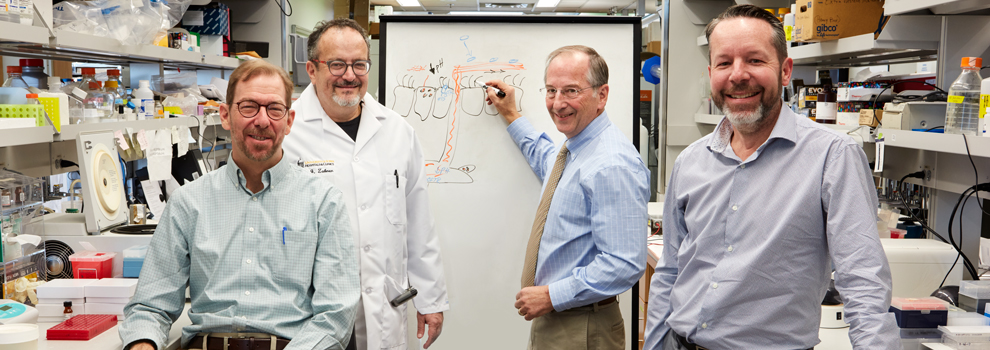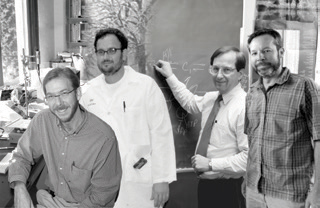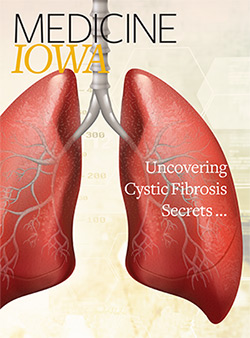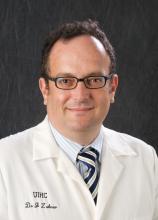
Decades of research make Welsh a national leader in the fight against cystic fibrosis

Three decades of delving into the mysteries of cystic fibrosis (CF) began with simple, fundamental curiosity. “I just wanted to understand how the airway worked,” says University of Iowa pulmonologist Michael Welsh, MD. In particular, he wanted to know how salt ions move across airways—a biological process that helps lungs defend against infection or damage from inhaled pathogens and particles. Knowing that CF increases susceptibility to lung infection, Welsh suspected that abnormal ion transport could play a role in CF disease.
Working with colleagues from the University of California, San Francisco, in the mid-1980s, Welsh first demonstrated that CF disrupts chloride ion transport across airway epithelium. This significant finding preceded the discovery of the cystic fibrosis transmembrane conductance regulator (CFTR) gene by four years. Once the gene was revealed, Welsh and his colleagues set off to decipher the molecular pathogenesis of the disease. First, they showed that the function of the CFTR protein was to act as a portal for chloride ions, and later they discovered that the protein was also required for movement of bicarbonate ions.
“The work done by Mike Welsh and his team at the University of Iowa has advanced the understanding of CF among physician-scientists around the globe.”
---
Francis Collins, National Institutes of Health
Impacts of the research
Over the decades since, hundreds of scientists at the UI—from undergraduates to established researchers and physician-scientists—have contributed to efforts to slow the progression of CF. Their work has helped increase the lifespan of patients from very early childhood to middle age, with the prospect of even greater gains coming from newly approved drugs that target CF defects directly. “The work done by Mike Welsh and his team at the University of Iowa has advanced the understanding of CF among physician-scientists around the globe—myself included—and provided so many patients with CF hope for a better future for the next generation,” says Francis Collins, MD, PhD, director of the National Institutes of Health (NIH).
In 1989, Collins, then at the University of Michigan, led one of the three groups that identified the CF gene. Funds from the NIH and the Cystic Fibrosis Foundation Research Development Program established the UI Cystic Fibrosis Research Center in 1988. And since 1993, UI scientists working on CF have received more than $80 million in continuous funding from the National Heart, Lung, and Blood Institute and the National Institute of Diabetes and Digestive and Kidney Diseases, both part of the NIH.
Welsh and his team continue their journey in understanding CF disease

Welsh leads a CF team that includes UI pulmonologists Paul McCray, MD, David Stoltz, MD, PhD, and Joseph Zabner, MD. Together, these researchers have made important discoveries about the fundamental biology of the CFTR protein and developed a systematic classification scheme of how different genetic mutations can “break” the CFTR protein. They have created unique cell and animal models of CF that revealed new targets for treatment, and they have made progress toward the ultimate goal of developing a one-time gene therapy treatment that could potentially cure CF. “Our work is really enabled by a very close collaboration between the researchers in the lab as well as providers taking care of people with CF in the clinic,” Stoltz says. “We hope that discoveries from the lab will lead to new and exciting treatments and medications. We also know that things we learned from taking care of people with CF will lead to new discoveries that ultimately generate new medications and treatment strategies.”
Looking to the future of CF research
Three decades into the journey, Welsh’s fundamental curiosity remains strong, and his passion for understanding and overcoming CF disease grows exponentially. “This is really an exciting time in cystic fibrosis. Research on CFTR—understanding what it does and understanding why it doesn’t work when it’s mutated—has led to the development of at least three drugs that are approved by the FDA that are effective for people with CF. They’re not perfect yet, but they keep getting better. That work is changing the lives of people with CF,” he says.
Meet the lung biology team
|
Paul McCray
|
Joeseph Zabner, MD
|
Michael Welsh
|
David Stoltz, MD, PhD
|
By Jennifer Brown
View other features on cystic fibrosis research

Featured in Medicine Iowa Spring 2018
You're reading one of the features included in the Spring 2018 issue of Medicine Iowa. Read more news and features about the people and programs focused on teaching, healing, and research in the UI Roy J. and Lucille A. Carver College of Medicine.



